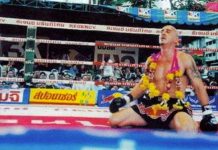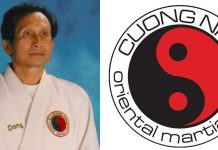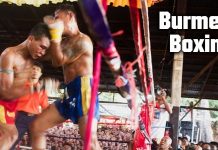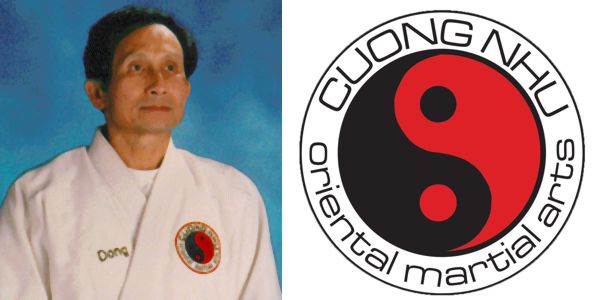 The Vietnamese martial art of Cuong Nhu was born in 1965. Although its peers may consider the system a “youngster”; Cuong Nhu’s foundation is as old as the oldest martial art.
The Vietnamese martial art of Cuong Nhu was born in 1965. Although its peers may consider the system a “youngster”; Cuong Nhu’s foundation is as old as the oldest martial art.
Literally translated, Cuong Nhu means hard and soft. The hard or Cuong techniques are the system’s blocks, punches and kicks. The soft, or Nhu, denotes the styles circular movements of Aikido, Wing Chung and Judo. All of these techniques were incorporated into the original Vietnamese fighting art of Vovinam. The art of Cuong Nhu is the result of combining Shotokan, Tai Chi, Wing Chung, Judo, Aikido, boxing and Vovinam.
“The combination of all these options really creates a nice balance which is what I believe sets our system of Cuong Nhu apart from other martial arts,” says Mark Colangelo, Chief Instructor of Cuong Nhu’s Setting Sun Dojo in Ocean Beach California.
“The primary difference between Cuong Nhu and other styles is the diversity. Students going to another dojo may only be exposed to one style of training. In Cuong Nhu it is required that all of our students be exposed to a variety of systems. We aren’t about doing just one thing. We learn a Shotokan response to an attack, then an Aikido, Wing Chung, and Judo response to that same attack. We feel that this gives our students an option if they are ever put into a situation where they must defend themselves. For example, if the attacker is out to really hurt you, a vicious, hard response may be in order. However, if the attacker is only intoxicated, you could use Aikido or Judo to control them without doing any real harm to that individual”.
For their hard or Cuong techniques, this system has adapted a traditional Japanese Karate art.
“Our hard style techniques are pure Shotokan, “ says Colangelo. “We teach Shotokan katas in addition to a form created by our Grand Master, which we just call kata 2. In addition, before receiving a black belt, our students must learn the first Wing Chung kata. So by the time someone achieves a black belt in Cuong Nhu they have had substantial exposure and have learned the principles of Shotokan, Wing Chung, Judo and Aikido”.
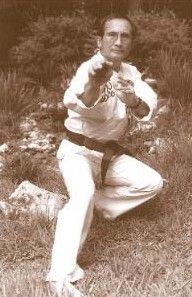 The systems founder, 63-year-old Master Ngo Dong trained in and mastered all of the above mentioned systems. However, his initial training was in Vovinam, a Vietnamese form of hand and foot fighting.
The systems founder, 63-year-old Master Ngo Dong trained in and mastered all of the above mentioned systems. However, his initial training was in Vovinam, a Vietnamese form of hand and foot fighting.
“Vovinam’s empty-hand techniques are grouped into animal styles,” explains Master Dong. “From hard, linear and powerful techniques, to soft, circular and yielding ones. Vovinam’s training begins with the tiger style followed by the monkey, crane and panther styles. The snake style is taught last.”
Power and strength characterize the Vietnamese tiger style. The panther style is very mobile and quick using a variety of flying kicks. The monkey style emphasizes grappling and infighting techniques. The crane style includes long range circular motions and fast hooking parries. The snake is the most efficient of all the Vietnamese animal styles, and is probably the best system for fighting larger opponents. Its arsenal includes throws, sweeps, stamping kicks and flying kicks.
The snake stylist does not directly oppose his opponent’s strength. He relies on deception and indirection to get the upper hand utilizing feints and fakes against his opponent. Most snake strikes are delivered with the spearhand, which is aimed at the eyes or throat.
As a youngster growing up in Vietnam, Dong and his two brothers put the art of Vovinam to task as they frequently found themselves in brawls on the streets and alleys of Hanoi. It was in these early “gang fights” that Dong proved himself to be a skillful fighter.
“All Vietnamese children were instructed in martial arts because, in my country street fighting takes place anytime, any where,” recalls Dong. “ Fights occurred daily, so everybody has to learn something to be safe.”
Dong was a skillful fighter, even better than his older brothers were.
“I was successful because I was very careful not to let an opponent gain what might be the fatal edge,” says Master Dong. “I never left home unarmed and I trained myself to recognize individuals who might cause trouble.”
Another precaution he took was to stuff half a dozen issues of Life Magazines inside his shirt whenever he left the house. This crude vest proved him with a measure of protection against a knife attack.
Following a vicious knife fight that left his two brothers seriously wounded, Dong realized that violence was not the way to solve his problems.
“When I fought like a hoodlum I became as bad as them,” recalls Master Dong. “At the age of 18 I put an end to my years of senseless fighting. My decision came with maturity.”
In 1954 political turmoil in Vietnam split the country and Dong’s father moved his family from the communist North to Saigon. Dong’s brother continued to recover from a knife wound to the stomach and began studying Tai Chi Ch’aun and acupuncture. He eventually taught his younger brother Dong the Tai Chi forms. The young Dong also took up Western boxing while living in Hanoi. At the same time he also began training in Wing Chun under Grandmaster Te Kong.
Dong and his brothers combined the Wing Chung techniques along with the Ngo family style of boxing and Vovinam. The original name of this style was Viet Vo Dao meaning the way of Vietnamese Martial Arts, as its name implies. Grandmaster Nguyen Loc formally organized this style in 1946. Grandmaster Loc was previously skilled in many aspects of Ju-jitsu.
At the age of 19 Dong took up Shotokan Karate under a Japanese captain, Choji Suzuki who later founded Suzucho Karate. Suzuki had remained in Vietnam following World War 11. He taught Taken-uchi-ryu and Shotokan to the Vietnamese police.
Dong trained fanatically and obtained the rank of 4th degree black belt under Sensei Suzuki.
Following his years of hard training in Shotokan, Dong discovered judo and Aikido in Hue. His judo teacher was hard-core Marine Judo champion Earnie Cates who at the time was doing a tour of duty in Vietnam. In 1960 Cates was a member of the United States Olympic Judo team. He and Dong remain friends to this very day and continue to train together.
“After all of this training I began to appreciate the effectiveness of soft style techniques like Wing Chung,” admits Dong. “At first I felt that soft techniques were of little value because they did not seem effective in a street fight. There came a time during my training with Sensei Suzuki that felt a void. I felt as if there was not enough spiritual emphasis on Ki in the hard style as compared to what I had learned in Aikido and Wing Chung. Anyone can learn to kick and punch and never have a reason to use these skills in daily life. I wanted to focus more on the building of moral character.”
With that goal in mind Dong began to train his spirit as well as his body.
“I did not abandon Shotokan totally,” says Dong. “For me karate is a way of life. It is a tool to use and not an end in itself. So I began to modify the Shotokan techniques and combine them with the soft styles I had also learned.”
In 1965 Ngo Dong founded Cuong-Nhu, hard-soft Vietnamese Karate. His system caught on quickly and in less than five years Dong had over 3,000 students. It became the third largest martial arts school in Vietnam.
However the dark cloud of war hung over Vietnam and in 1975 the Communists took over the country. Dong at the time was President of Quang Da College in Da Nang. Like all remaining intellectuals, he and his family were kept under close observation.
It soon became apparent to Dong that he must escape or perish under the heavy hand of communism. The following description of Dong’s flight to freedom was taken from Dragon Nhus, a publication of Cuong Nhu Oriental Martial Arts special edition newsletter.
“I was bathed in a fever and felt very sick, but I knew there was no other choice, we had to escape,” said Dong about his decision to fee Vietnam.
In a daring escape, Dong, his family and 19 others made their way to freedom. What they went through in order to fool the communist, and eventually evade their pursuit is a story that could be a movie-of-the-week.
Dong had been in the United States prior to the fall of Saigon. After completing his studies at the University of Florida in Gainesville he returned to Vietnam. Shortly thereafter, in 1975, South Vietnam fell to the Communist government and Master Dong and his family were placed under house arrest. Word filtered back to him that he and his family were to be executed.
The communists accused him of being a spy. Anyone who ventured out of the country and returned was suspected of covert activities. For 2 years, 2 months, and 20 days he and his family were under guard 24 hours a day. The political situation was growing worse. The Vietnamese martial arts master feared for his life, and the life of his family.
He was able to contact a boat owner who agreed to smuggle Dong and his family out of the country, however the cost of the journey was beyond Dong’s financial means. Unable to secure the necessary money for the trip, Dong made a deal with the boat owner. He offered him protection against pirates in return for passage.
Once the deal was made it was essential that Dong’s plans remained a secret. To make sure that word didn’t leak out about his escape, Dong told no one about his plans.
“We couldn’t let the kids in on the escape plan other wise they’d go around saying good-bye to their friends and we’d have been finished,” recalled Dong.
When the family arrived at the pier on the night of the escape, they discovered there were 15 additional passengers on the 20-foot boat. The boat owner had lied about the number of people being transported among other things. The tiny craft; had only 1 engine, not 3 as he had previously indicated, and it ran like a lawn mower. After many loud attempts to start the engine, it finally kicked in, however they were stilled tied to the dock. The well-planned escape wasn’t off to a very good start.
“I just knew we were going to be arrested at any moment,” said Dong about that night.
Early the next morning, an old man who had been sleeping off a drinking binge come up on deck and attempted to reverse their course. Dong flew into action immediately.
“I grabbed him and tied him up,” said Dong. “I left him tied for several days. He cursed at me the entire time. The day we saw our first ship I grounded charcoal and wrote ‘SOS’ on a bed sheet. It was a dangerous move, but one I thought necessary. The ship, a Toyota freighter, slowed down. They looked us over, then kept on going. Twelve other ships passed us during the next few days as well. I was still very sick, but everyone was relying on me. So, I kept the discipline on ration distribution to keep us going.”
Eventually, an Indonesian ship spotted them and stopped. Dong convinced the crew that the small boat was taking on water. They dropped a rope and he climbed onto the ship’s deck to speak with the man in charge. He was a Lieutenant Colonel from Indonesia who had a girl friend in Vietnam and was very sympathetic to Dong’s plight.
Dong talked them into lifting his boat onto their deck for repairs.
“Our boat looked like a fly on a buffalo,” said Dong. “During the day, the ships crew would do some repairs on our boat so we could continue our voyage. At night I would sneak onto the boat and sabotage their work, I was stalling for time.”
Five days later they arrived in Indonesia. They remained there for 3 months awaiting their visa process to enter the United States.
It was November 1978 and Gainesville was celebrating homecoming day when the Ngo family arrived. It was perfect timing as the Cuong Nhu students had labored over a huge floating dragon made out of paper mashie for the parade. It was an emotional moment for Dong and his family as his American students welcomed him and his family to their new home.


